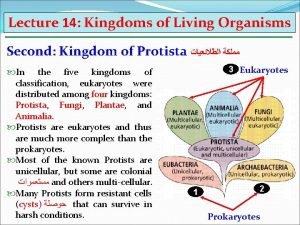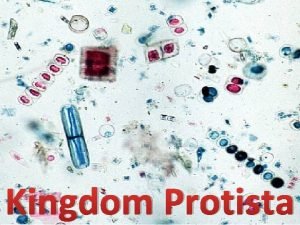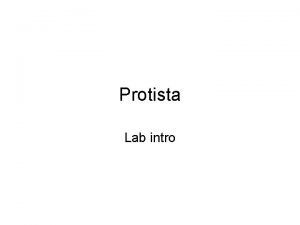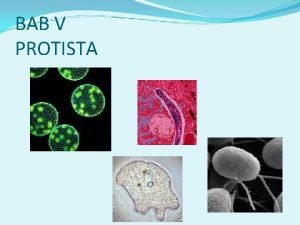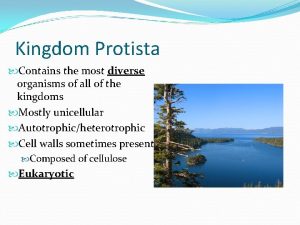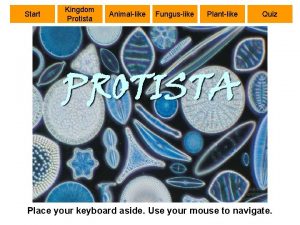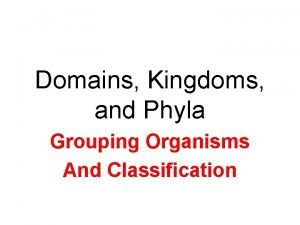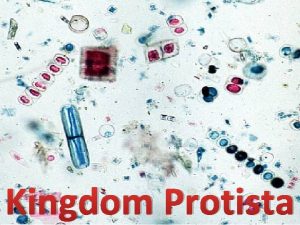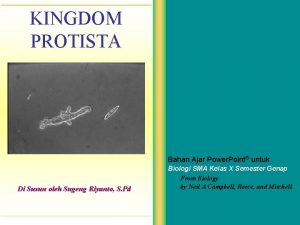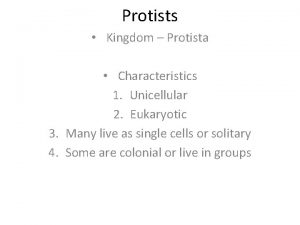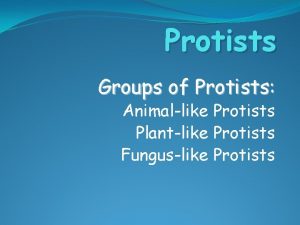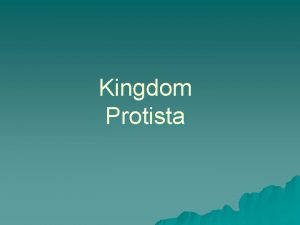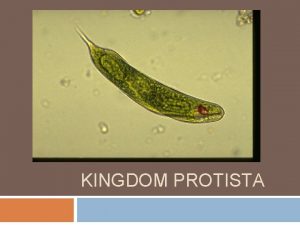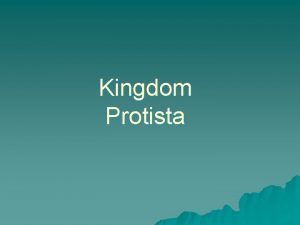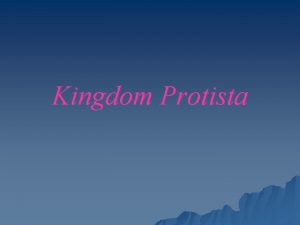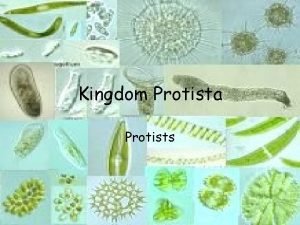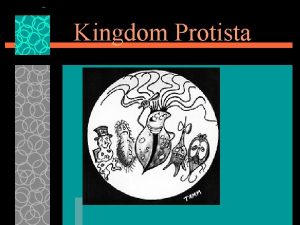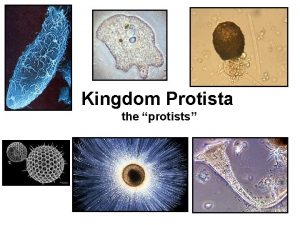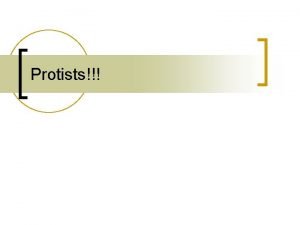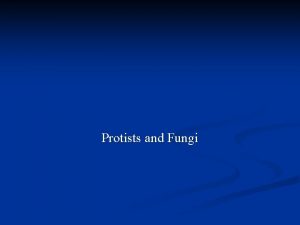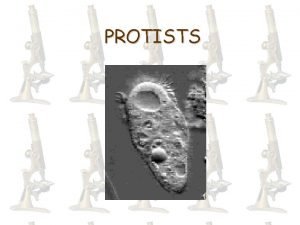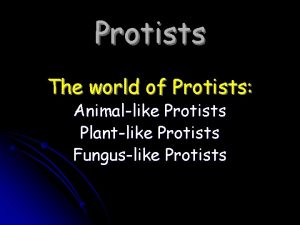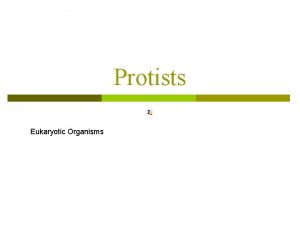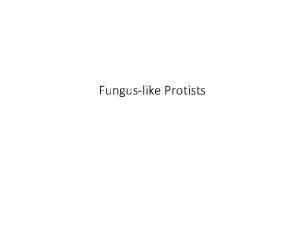Kingdom Protista Protists Kingdom Protista The kingdom Protista


















- Slides: 18

Kingdom Protista Protists

Kingdom Protista • The kingdom Protista includes eukaryotic organisms that don’t belong in one of the other eukaryotic kingdoms (Plantae, Animalia, or Fungi) – These organisms share traits with these other groups; just not enough to be classified with them

Kingdom Protista • Protists can be singlecelled or multicellular organisms. • All protists are eukaryotes. • Groups of Protists: – Protozoa (Animal-like) – Algae (Plant-like) – Fungus-like forms

Examples of Protists • Includes: Amoeba, Naegleria fowleri Flagellate, Giardia lamblia Ciliate, Strombidium – – Amoebas Ciliates Flagellates Algae

Protozoans • Protozoans: animal-like protists – These protists share characteristics with animals such as: • Feed on other organisms • Cells lack cell walls – Examples: • A) Zooflagellates – Move around using flagella • B) Sarcodines – Move using pseudopods (“false feet”) – Amoebas • C) Ciliates – Move using cilia: short hair-like projections • D) Sporozoans – Do not move on their own – Are parasitic Ciliate

Algae • Algae: plant-like protists – These organisms share characteristics with plants such as: • Photosynthetic • Cells contain cell walls – Examples: • A) Phytoplankton – algae that live near the surface of the ocean. • B) Red, brown or green algae • C) Diatoms – have silicon in their cell walls) Diatoms

Algae • Besides oxygen production, algae are used by humans for many other purposes: – A) Food • seaweed & kelp are edible (Sushi anyone? ) – B) Production of agar • Gelatin-like substance that has many uses – C) Used to make toothpaste “pasty” – D) Others?

Fungus-like Protists • Like fungi, these are usually decomposers. – Absorb nutrient from dead or decaying matter Slime Mold • Fungus-like protists do not have chitin in their cell walls like true fungi do. – Slime molds – Water molds

Kingdom Fungi

Kingdom Fungi • Eukaryotic organisms that primarily feed on dead or decaying matter. – Grow on their food source – Secrete enzymes that digest their food outside their bodies – Absorb nutrients through their cell walls • Can be multicellular (mushrooms, molds) or unicellular (yeasts)

Role of Fungi in Ecosystem • Fungi are called “The Great Decomposers” – Breakdown organic material and recycle it in nature • Fungi also form mutualistic relationships with other organisms – Ex: mycorrhizae • Mutualistic relationship between algae and a fungus – Algae makes food & fungus provides minerals

Characteristics of Fungi • Fungal Structures – Have cell walls, made up of chitin, a carbohydrate that also makes up the exoskeleton of insects. – Hyphae: thin filaments that make up most fungi. – Mycelium: many hyphae tangled together that help the fungus absorb food. • Typically grow under the surface – Fruiting Body: the reproductive structure of the fungus (Example: mushrooms)

Characteristics of Fungi Fruiting Body Spores

Types of Fungi • Mushrooms – Multicellular, most complex of fungi • Molds – Multicellular – Not usually visible until fruiting bodies appear • Yeast – Unicellular, simplest form of fungi

Fungal Reproduction • Reproduce both asexually and sexually. • Asexual Reproduction: – Hyphae break off and begin to grow on their own. – OR, fungus produces spores that are released and can grow on their own. Mold spores

Fungal Reproduction • Sexual Reproduction: Requires fungi of two different mating types, called either + (plus) or – (minus) – When a + hyphae and a – hyphae meet, they fuse together. – The fused hyphae grow and form a diploid zygote, which then will go through meiosis. – Meiosis produces haploid spores, which are able to grow on their own.

Uses of Fungi • Humans use fungi for a variety of purposes: – A) Food • Edible mushrooms, yeast (make bread) – B) Food production • Certain fungi can be used to flavor foods (ex: the “bleu” in bleu cheese – C) Biotechnology – D) Medicines • antibiotics

Parasitic Fungi and Fungal Disease • Most fungi that cause disease in humans are opportunistic pathogens, meaning they only infect people with weakened immune systems. – Ex: athlete’s foot, ringworm, jock itch, etc. • Most parasitic fungi infect insects and plants, many times killing their host.
 Macronucleus
Macronucleus Mentohotep
Mentohotep Old kingdom middle kingdom new kingdom
Old kingdom middle kingdom new kingdom Nnn ruled
Nnn ruled Old kingdom middle kingdom new kingdom
Old kingdom middle kingdom new kingdom Baccilariophyta
Baccilariophyta General characteristics of protista
General characteristics of protista Protista kingdom
Protista kingdom Archaebacteria dan eubacteria
Archaebacteria dan eubacteria Protista lab
Protista lab Protista, fungi, plantae, animalia *
Protista, fungi, plantae, animalia * Ciri umum protista
Ciri umum protista Which kingdom is most diverse
Which kingdom is most diverse Protist evolution
Protist evolution Eubacteria examples with scientific names
Eubacteria examples with scientific names Kingdom protista characteristics
Kingdom protista characteristics Kingdom protista prokaryotic or eukaryotic
Kingdom protista prokaryotic or eukaryotic Ppt kingdom protista
Ppt kingdom protista 2 characteristics of protista
2 characteristics of protista
